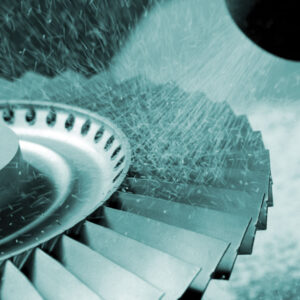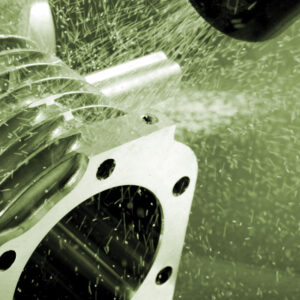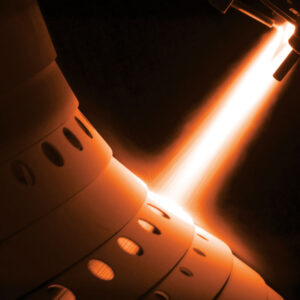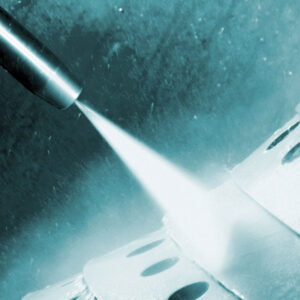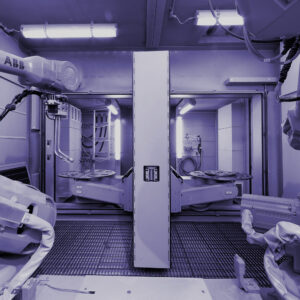Masking tools used during the EB-PVD coating of aircraft components are very expensive, making it imperative to extend their lifespan as long as possible. While HF (hydrofluoric acid) furnace, FIC (fluoride ion cleaning) and other traditional methods can be used to remove coatings using heat and chemicals, the use of ultra-high pressure waterjet stripping can significantly increase the number of cycles users can expect from their expensive masking tools. Ultra-high pressure waterjet stripping has been proven to significantly reduce contamination, thereby allowing for increased yield on subsequent coating cycles.
Ultra-high Pressure Waterjet Stripping vs Chemical Heat Processes
Chemical processes tend to break a tool down over time, making it brittle and even causing it to crack at its welds. By contrast, waterjet stripping is able to run at much faster cycle times and is much gentler on tooling than other coating removal methods, allowing the tooling to be reused more times. Additional benefits include the following:
- The reduction of contamination, resulting in increased yields on every coating cycle.
- The waterjet stripping machine can be just adjacent to where the coating is happening, rather than in a special area such as where the chemical process might have to live within your facility.
- Since the removal method just uses straight water, the addition of a filtration system can create a zero-discharge process.
- The process can handle single piece flow, and it’s very fast, so that it’s very efficient from a cost standpoint.
The Ultra-High Pressure Waterjet Stripping Process
Progressive Surface PVD coating removal machines feature a turntable system with a spindle inside the cabinet and a spindle outside the cabinet, which are swapped during each cycle for easy operator loading and unloading. This exchange gives the operator time to remove the completed part and add a new part. The high-pressure water jet operates at 55,000 psi, and the rotating nozzle ensures all surfaces are reached with the water.
The Progressive Surface PRIMS Pro® interface simplifies the operation of the robot arm nozzle manipulator. The PRIMS Pro “Surface Select” feature aids the operator when the first cycle does not remove the coating completely; in that case, the operator is able to select specific surface subroutines by simply checking or unchecking the surface description in the PRIMS Pro screen. The next cycle will only repeat the sections of the part program necessary for complete coating removal, thus reducing cycle time and minimizing erosion of the substrate.
Increased Productivity
Progressive Surface’s customized ultra-high pressure waterjet stripping machines take between one-and-a-half minutes per part for smaller parts, to up to 15 minutes for larger parts. To increase productivity in the processing of larger parts, Progressive Surface has designed a machine featuring two slides with three spindles on each slide. A robot exchanges the two spindle slides and directs the water jet spray at each tool or part in turn. This way, the operator is freed up for an hour or so to complete other tasks while the machine cycles through processing multiple parts.
Progressive Customizable Machine Solutions for Every Application
The Progressive Surface team is always working with our customers to figure out the best automation for their unique process. We use the Procise Process®—including thorough upfront discovery, process-specific design, and lifetime support—to ensure each customer’s unique needs are met. Find out how Progressive Surface can help make your process more productive, efficient, and reliable. Contact us today.
Frequently Asked Questions (FAQs)
Q: How does ultra-high pressure waterjet stripping compare to chemical heat processes for removing EB-PVD coating from aircraft components and tooling?
A: While HF furnace, FIC, and other traditional methods can be used to remove coatings using heat and chemicals, there is a better alternative. Ultra-high pressure waterjet stripping has been proven to achieve better throughput, reduce the contamination that can create significant problems during subsequent coating cycles, and increase tooling lifespan.
Q: What are the downsides to using chemical + heat processes to remove EB-PVD coating from aircraft components and tooling?
A: A tool that is subjected to chemical processes will tend to break down over time, becoming brittle and even cracking at the welds. By contrast, waterjet stripping is able to run at much faster cycle times and is much gentler on tooling than other coating removal methods, allowing the tooling to be reused more times. Typically, chemical coating removal equipment has to be housed in a separate part of the facility, whereas a waterjet stripping machine can be placed adjacent to where the coating is happening. Finally, chemical coating removal requires special handling for discharge; because the waterjet stripping method uses straight water, the addition of a filtration system can create a zero-discharge process.

